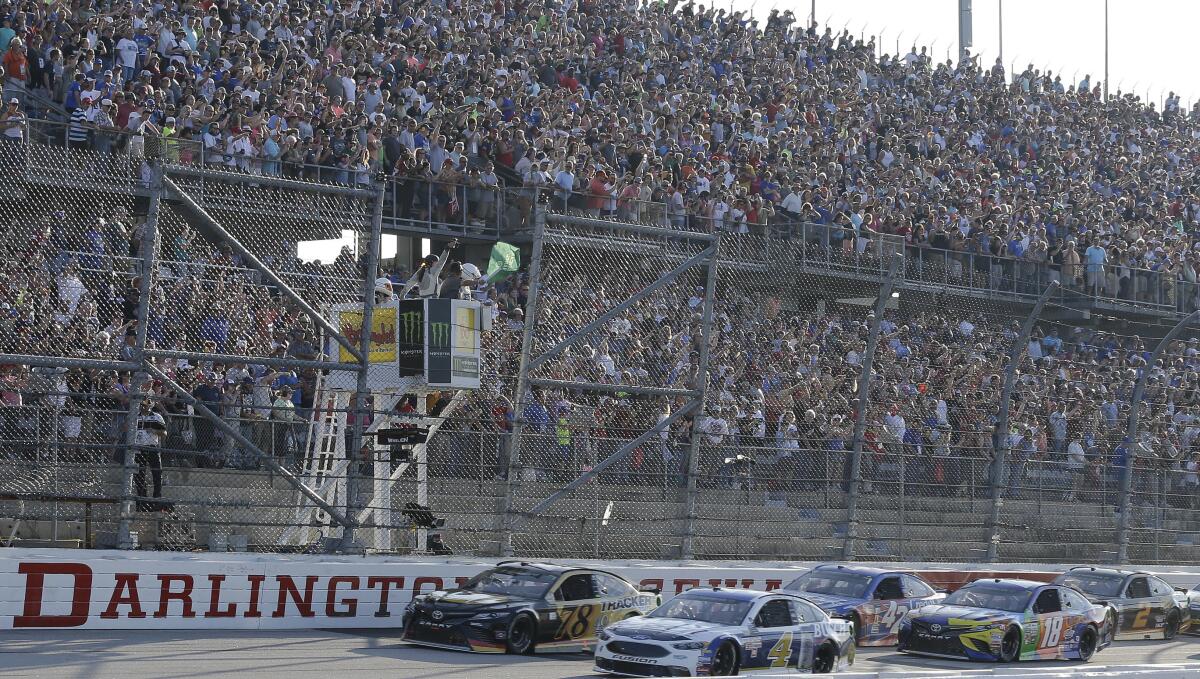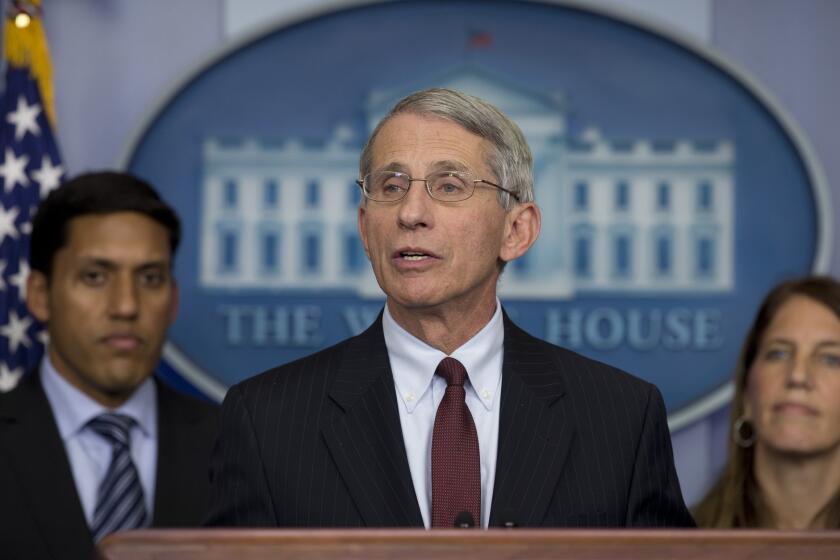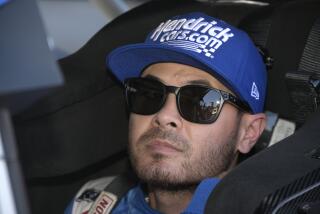NASCAR restarts Sunday as industry tries to stay out of the pits

- Share via
It felt like a scene from a movie or maybe a cheap novel: A stock car track in the South, two cars thundering down the backstretch, jockeying for the lead.
As Cale Yarborough tried to pass on the final lap, he and Donnie Allison bumped and hit the wall, spinning helplessly in a tumult of broken metal and smoke.
Squirming from his wreck as Richard Petty sailed past for the win, Yarborough commenced trading punches with Allison’s older brother, Bobby, on the infield grass. “It was great racing, great fighting and a great time,” Yarborough said.
But the 1979 Daytona 500 became a watershed moment in NASCAR history for reasons beyond that raucous finish.
On the same weekend, a crippling blizzard struck the East Coast and parts of the Midwest, with major cities lurching to a halt. Bad weather translated into very good television ratings for Daytona.
“They had a lot more people watching because they were stuck at home,” said Nate Ryan, a motorsports writer for NBC Sports. “A lot of people point to that being an example of why NASCAR took shape and took off.”
Dr. Anthony Fauci, departing from Trump’s line, warns Congress that reopening too soon during the coronavirus outbreak could trigger new outbreaks.
Not that anyone might equate a snowstorm to the coronavirus pandemic, but there is an important parallel.
With a series of races starting Sunday, NASCAR will get the jump on other major sports in returning to network television from the COVID-19 lockdown. Once again, it has a chance to grab the national spotlight.
“I really think we can put on great shows and do that safely,” driver Alex Bowman said. “And I think that will be really good for everybody.”
The stakes are high — this time, NASCAR is fighting a slump in popularity — and it could take something drastic to attract new fans. As officials gamble on racing in a pandemic, some people wonder if this might be the time for fundamental change.
::
There is no question that Americans are hungry for live sports. Over the past six weeks, millions have watched network broadcasts of NASCAR drivers competing against each other in iRacing — basically a super-charged video game.
“People tuned into this, people who hadn’t watched a real race this year,” said Steve Myers, the executive producer of iRacing’s pro invitational series. “If NASCAR retained even 10% of those people, it’s a win.”
Now comes the real thing, beginning with the Darlington 400 in South Carolina. Kicking off four Cup races and three other events in 11 days, officials know they must avoid a dangerous — and potentially embarrassing — outbreak among drivers and crew.
“It’s a big factor in terms of getting it right,” said Steve O’Donnell, executive vice president of NASCAR. “We realize up front it’s a huge responsibility for us as a sport.”
The stands will be empty and there will be social distancing along pit row. Teams won’t get any practice sessions or qualifying, no chance to make pre-race adjustments to the cars, so the restart could be wild.
“I do feel like there’s going to be some mistakes made, some bounces off the wall, things like that,” driver William Byron said. “You have to avoid that in the first run or so.”

With so many variables already in play, is this an opportunity? Ryan senses that officials have “indicated a willingness to make adjustments because everything feels like it’s on-the-fly in this world.”
The success of the 90-minute iRacing broadcasts has reinforced an already existing push for shorter Cup Series events.
“I don’t think we need all those four-hour races,” said Myers, a long-time motorsports fan. “It’s hard to ask a family guy to carve out that much time on a Sunday.”
Shifting away from traditional, oval tracks — at least some of the time — could counteract NASCAR’s reputation as a “left-turn league.”
More road courses, popular in the past, could help. So could the occasional dirt track and street circuits akin to the Long Beach Grand Prix. NASCAR has planned a first-ever doubleheader with IndyCar later in the year.
“It really is about the fans,” NASCAR president Steve Phelps said recently. “We need to make sure we are putting on compelling racing and having full grandstands when we do that.”
Another thing about the iRacing series — it helped personalize a sport born of moonshine runners and larger-than-life personas. Fans saw drivers’ faces normally obscured by helmets and window nets. They listened to favorites talk strategy and crack jokes.
“Man, this is worse than real life,” Clint Bowyer said after crashing with Bubba Wallace in a simulated race at Bristol Motor Speedway. “C’mon, Bubba!”
Not that everything went smoothly. Kyle Larson got fired by his team after blurting a racial slur. Wallace lost a sponsor for “rage-quitting” — a gaming term — after the mixup with Bowyer.
“This is why I don’t take this [expletive] serious,” Wallace said. “Peace out.”
Still, the sport could benefit from being loose and open when real-life competition resumes. Teams could add cockpit cameras to augment television coverage. Drivers could stream in-race on platforms such as Twitch and Facebook Live and give candid interviews over the radio during cautions.
“They probably wouldn’t want to let their guard down,” Ryan said. “But I think there are enough benefits to giving fans more of that experience that it would be worth it.”
Myers talks about “drivers enjoying themselves. By them having fun, it almost transfers to the viewer.”
::
Sagging attendance and weaker television ratings — in decline despite a mild bump last season — aren’t the only challenges.
A 2017 study commissioned by SportsBusiness Journal put the average age of NASCAR audiences at 58, third-oldest among major sports behind golf and tennis. It was also nine years older than a decade earlier.
Major League Baseball players won’t blindly follow any roadmap presented by team owners to start the season, but they have a lot to potentially lose.
The playoffs have added spice to the late-season and stage points — awarded at various spots in the race — have aimed to reduce the lulls when cars parade endlessly with few lead changes.
Officials hope to connect with a younger demographic by introducing a Gen-7 car that looks more like something off the showroom floor. There could be tweaks to a schedule that has the biggest event of the year — the Daytona 500 — at the very start.
Fans have also clamored for fewer technical rules and fewer of the awkward situations that have on-track victories taken away when cars fail post-race inspections.
O’Donnell, the NASCAR executive, sees the coming months as “a fluid situation, we’re going to need to factor in many, many variables.” The question is, will a good ol’ boy sport be willing to evolve?
“It will be interesting,” Ryan said. “I think there’s going to be a lot of opportunity to assess things.”
More to Read
Go beyond the scoreboard
Get the latest on L.A.'s teams in the daily Sports Report newsletter.
You may occasionally receive promotional content from the Los Angeles Times.













